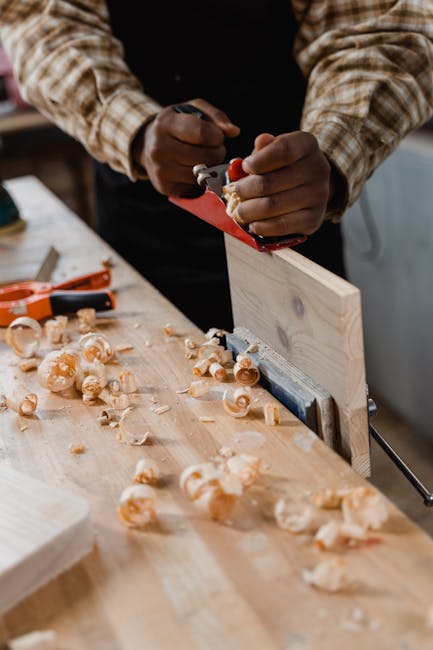Hello, Shoyan here. I’m a Japanese carpenter. This time, I’d like to install the sash and the noki-ten of the noki-ura. (Eaves) First, I’ll install the frame for the front door sash. I’m going to put it on the pillar on the right side. So, I’ll make sure that the pillar is completely vertical. If the base is cut off, it’s necessary to check that it is vertical. This sash is an angle* type. If you use a ready-made decorative product, you can attach it directly to the pillar. I’ll use a 33 mm decorative wooden frame for finishing. So, I’ll attach the packing* on that part and adjust the intervals. A sash is generally a frame used for a window or entrance that is on an exterior wall. Aluminum isn’t the only type of sash. There are also wooden sashes. What I’m going to install now is a regular aluminum front door sash. This one will be a sodekabe* with studs installed. A 25 cm display shelf will be placed on the interior side of the entrance. That’s why the wall will be installed here.
The wall is a little bit inside, and this way, the rain will not enter the house. Installing window sashes isn’t a difficult job. It’s simple as long as the foundation for the frame is installed vertically, leveled, and not warped. Install the frame. This door sash is equipped with an electronic lock. It can be locked and unlocked from the inside with the flick of a switch. It’s a very convenient feature. Now, install the sash frame. It’s a little tricky to fit because there’s a power cable.
I’ll make sure the cable is not too tight. Next, check the level. Also, measure the diagonal line at the same time. If you match the diagonals in millimeters, the sashes will always be at right angles. For finishing, apply waterproof tape to the outside of the sash frame. Although rainwater won’t reach this point, I apply waterproof tape on the door just in case. The installation of the front door sash frame is complete. This is a long, narrow window that opens and closes by raising and lowering. It only opens about a third of the way. The lower fitting* goes up, and only the lower part opens. This is the easiest type of sash to install. It can be attached by simply tightening the screws from the outside. Next, I’ll install the living room’s hakidashi* sash. This will be the largest sash in the house.
The height is 2 m, and the width is 2,600 mm. It is a hakidashi sash with shutters. When installing a hakidashi sash, place the support material precisely on the foundation and install it by securing the packing material to the sides. This sash is equipped with shutters on the outside of the fittings. In the case of a sash with shutters, make sure the sash frame doesn’t warp inwards too much. If it is warped, the shutter will not attach properly. A secret scroll is attached to the inside of the shutter box. I’ll apply the scroll. Actually, it’s just a waterproof sheet. I wonder if the rain ever gets inside this. Apply waterproof tape to this sheet as well, just in case. Also, apply waterproof tape around the outside. Put the screw cover on. The installation is complete. They brought the fittings at just the right time. It is a gorgeous double sliding fitting. It would be expensive to break them. From here, I’ll install the foundation of the noki-ten of the noki-ura. The material is called “nobuchi.” It is 4 cm square. I’ll screw the 4 cm square nobuchi to the bottom edge of the rafters to make the foundation.

Put a piece of board for the foundation on both ends and install it accurately. The part that I’m installing the foundation for is called the “noki-ura.” You can also call it the “noki-saki,” but this part is actually the noki-ura. The noki-saki is the tip that protrudes about 10 cm from the hana-kakushi. People say, “I rent 3 sun of the noki-saki.” But 3 sun is only about 10 cm. It’s too small to shelter from the rain. The locations of the noki-ura and the noki-saki are a little different. Cut the noki-ten material. The material is 1 cm thick cedar board. These boards are mainly made of sapwood. But the colors are different, so I use different colors in different places. Noki-ten refers to the ceiling covering of the noki-ura. It doesn’t refer to the entire noki-shita, but to the decorative ceiling boards.
Japanese-style houses don’t typically use a noki-ten. The noki-ura is the exposed surface. The Noki-ura and the noki-ten look the same but are actually different. Line the pieces up and cut them to the correct length. Line them up, line them up, line them up. I’m not playing around. I line them up and draw the intervals to a handmade wooden ruler. That way, I’ll get the actual measurements, not calculations. I’ll measure the boards for all the eaves. First, I’ll install the noki-ura (noki-ten). Apply the glue and secure it with a 4 mm tacker. Locations beyond the decorative girder will be installed using the “yari-okuri” method. Attach it to the girder side first and then the hana-kakushi side. The part above the girder can be installed more easily as I simply insert it in. Install the noki-ten of the terrace. Just as the front door part was installed, it started to rain heavily. But the good thing about the noki-ten, of course, is that I can work under it.
I won’t get wet. Cut the noki-ten material for the terrace part. As I did with the material for the entrance, I’ll draw numbers on the noki-ten material and install it in the numbers’ order. I’ll use the same board for both the top and bottom of the girder. This way, when you sit in the living room and look at the top of the terrace, it uses the same board. The grain and pattern of the wood will be aligned longitudinally without any difficulty. It takes a little more time and effort, but I’m going to be very particular about using a single board. Install the noki-ten of the terrace in the same way. It’s a well-cut board, but it‘ll shift to either the left or right if I tap it to install as usual.
So, after four or five boards are installed, I install them while keeping a right angle. I can’t put the one that’s out of place back in place, but I can shift the one with room by 1 mm. Somehow, I keep the right angle until the end. This house is about 50 tsubo.* It takes about five days to finish Installing the noki-ten. It’s a tough and unpleasant job because I have to turn my head repeatedly to hit it to install it above me. However, it’s beautiful when it’s painted. Now I’ve finished installing the sashes. The windows can be closed since the fittings are installed. Also, I’ve installed the noki-ten. The girder is cypress, and the noki-ten is cedar. The white color matches and it looks beautiful. That’s all for today, thank you for watching..

